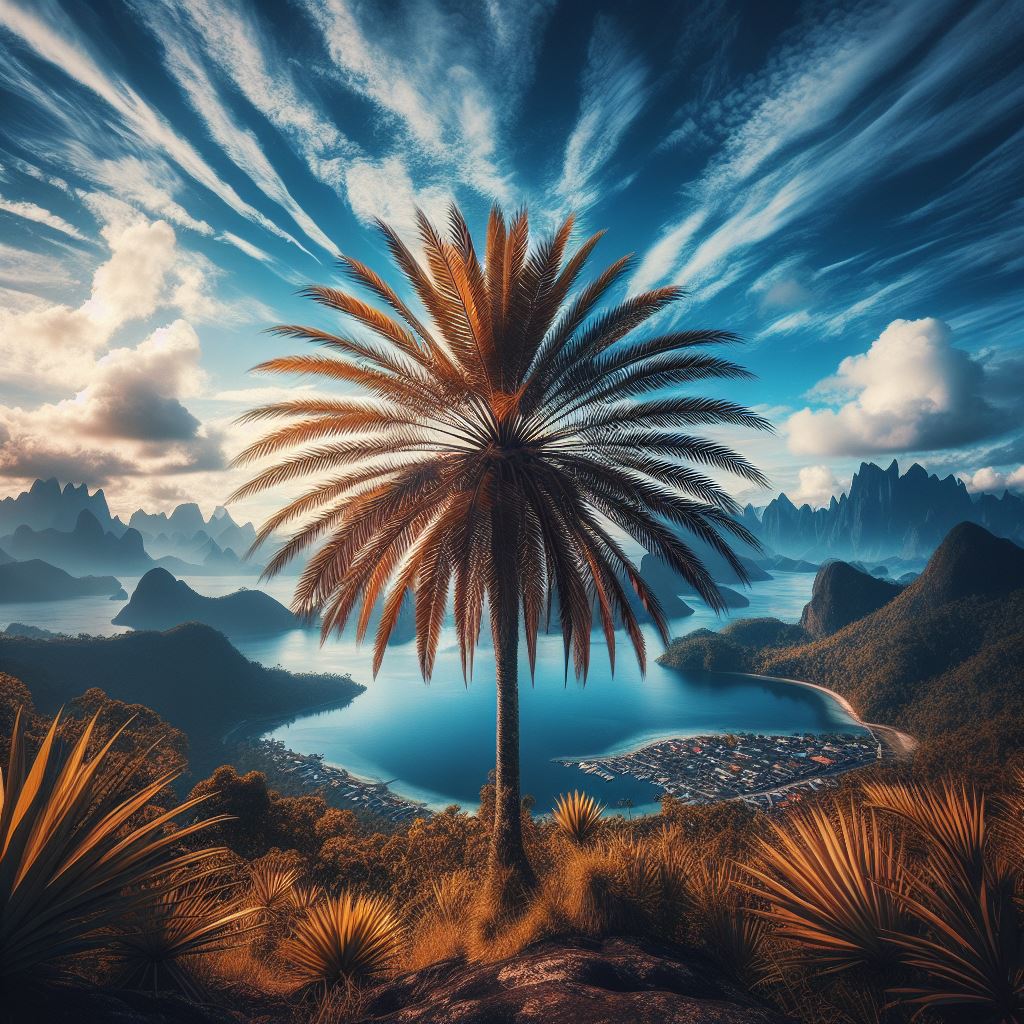Introduction:
Travelers Palm (Ravenala Madagascans) is a fascinating and exotic plant known for its unique appearance and tropical allure. Native to Madagascar, this stunning plant has captured the hearts of many plant enthusiasts around the world. so now, we will explore various aspects of Travelers Palm care, from temperature tolerance to landscaping around these majestic trees.

Understanding Travelers Palm:
The Travelers Palm, despite its name, is not a true palm. It belongs to the Strelitziaceae family and is botanically related to the banana plant. Its distinctive features include large, fan-shaped leaves that give the illusion of a traveler’s fan, thus earning its common name.
Temperature Tolerance:
Travelers Palms thrive in warm, tropical climates and are known for their excellent temperature tolerance. They can withstand a range of temperatures, but they prefer consistently warm conditions. In colder climates, it’s essential to protect the plant from frost, as prolonged exposure can damage the leaves.
Palm Tree Height and Characteristics:
Travelers Palms are renowned for their impressive height, reaching up to 30 feet in their natural habitat. When cultivated as a landscape plant, they can still grow to a considerable height. Their tall, slender trunks and large leaves make them a striking addition to gardens and tropical landscapes.

Palm Cutting and Propagation:
Propagating Travelers Palms is possible through seed germination or by using offshoots, also known as suckers. When taking palm cuttings, ensure they have roots attached and plant them in a well-draining soil mix. Regular watering and protection from harsh conditions will aid in successful establishment.
Dead Palm Tree: Signs and Solutions:
Like any plant, Travelers Palms can face issues, including the possibility of a dead palm tree. Recognizing signs such as yellowing leaves, decay, or stunted growth is crucial. If your palm shows signs of distress, prompt action such as pruning dead fronds and addressing root issues can help revive it.
Madagascar Palm Care:
Proper care for Travelers Palms involves providing well-draining soil, adequate sunlight, and regular watering. These plants also benefit from occasional fertilization, promoting healthy growth and vibrant foliage. Maintaining optimal humidity levels will mimic their native environment, ensuring their well-being.
Palm Tree Trimming Before and After:
Trimming Travelers Palms is essential for maintaining their aesthetic appeal and overall health. Pruning dead or damaged fronds should be done with care to prevent stress on the plant. Before and after palm tree trimming, it’s crucial to observe proper techniques to encourage healthy regrowth.
Landscaping Around Palm Trees:
Travelers Palms serve as captivating focal points in landscaping. Designing around these trees involves selecting companion plants that thrive in tropical conditions. Ground covers, colorful flowers, and other palm varieties can complement the unique beauty of Travelers Palms.
Palm Plant Turning Yellow: Causes and Solutions:
Yellowing of palm leaves can be indicative of various issues, including nutrient deficiencies or waterlogged soil. Understanding the causes and implementing corrective measures, such as adjusting watering routines or applying appropriate fertilizers, is vital to restoring the plant’s vibrancy.
Palm City Nursery and Plant Diversity:
Palm City Nurseries play a crucial role in providing enthusiasts with a diverse range of palms, including Travelers Palms. Exploring such nurseries allows for access to expert advice and high-quality specimens, ensuring a successful gardening experience.

Palm Tree Leaves Turning Brown: Addressing Common Concerns:
Brown leaves on Travelers Palms may signify problems like nutrient deficiencies, overwatering, or pests. Identifying the root cause and addressing it promptly through proper fertilization, adjusting irrigation, or applying appropriate treatments can restore the plant’s health.
The Palm Tree: Symbolism and Cultural Significance:
Beyond their horticultural value, palm trees hold cultural significance worldwide. They are often associated with tropical paradises and symbolize resilience, victory, and peace in various cultures.
Tree Types in Florida and Florida Tree Species:
Travelers Palms find a natural home in Florida, where various palm species thrive. Exploring the diverse tree types in Florida, including native and non-native species, enhances one’s appreciation for the state’s rich botanical tapestry.
Pygmy Palms Care: Miniature Marvels:
Pygmy palms, like the popular Roebelenii Palm, add a touch of elegance to landscapes. Understanding their care requirements, including proper watering and sunlight exposure, ensures these miniature marvels flourish in gardens and indoor spaces.
Plant Instructions and Palm Pros:
Following plant instructions and seeking advice from palm pros contribute to successful Travelers Palm cultivation. Professionals in the field can offer tailored guidance on specific care needs, pest management, and landscape design, ensuring a thriving and visually appealing garden.
Palm Plant Pests and Diseases:
Vigilance is crucial in protecting Travelers Palms from pests and diseases. Common issues include spider mites, scale insects, and fungal infections. Regular inspection and prompt treatment with organic or chemical remedies can prevent widespread infestations and keep the plant healthy.
Practical Palm Care Tips:
Enhance your palm care routine by providing proper support for the trunk in windy conditions. Mulching around the base helps retain moisture and regulate soil temperature. Additionally, periodic soil testing can guide fertilizer applications, ensuring the plant receives essential nutrients.
Travelers Palm in Indoor Spaces:
While typically an outdoor plant, Travelers Palms can be cultivated indoors if provided with adequate light. Ensure they receive bright, indirect sunlight and maintain a humid environment. Container gardening allows for flexibility in moving the plant based on seasonal changes.

Propagating Travelers Palms from Seeds:
Growing Travelers Palms from seeds offers a rewarding experience. Extract seeds from mature fruits, clean them thoroughly, and sow them in a well-draining mix. Patience is key, as germination may take several weeks. Provide consistent warmth and moisture for successful seedling development.
Fertilization Schedule:
Developing a regular fertilization schedule is essential for Travelers Palms. Use a balanced, slow-release fertilizer during the growing season to promote healthy foliage and robust growth. Adjust the application rate based on the plant’s size and specific nutrient requirements.

Watering Techniques:
Proper watering is critical for Travelers Palms. They prefer consistently moist but well-draining soil. Water deeply and allow the topsoil to dry slightly between waterings. Avoid waterlogged conditions, as this can lead to root rot. Adjust the frequency based on environmental factors such as temperature and humidity.
Palm Tree Identification:
Familiarize yourself with various palm tree species, including their distinct characteristics. This knowledge not only enhances your appreciation for the diversity within the palm family but also aids in proper care and maintenance, as different species may have unique requirements.
Caring for Newly Planted Palms:
Newly planted Travelers Palms require extra care to establish themselves. Provide a stable support structure, protect against harsh weather conditions, and water consistently to aid root development. Applying a layer of organic mulch helps retain moisture and provides insulation.

Landscaping Aesthetics:
Integrate Travelers Palms into your landscaping design for maximum visual impact. Consider factors such as height, spacing, and color contrasts with surrounding plants. Creating focal points and using palms as background elements can enhance the overall aesthetics of your garden or outdoor space.
The Art of Palm Tree Photography:
Capture the beauty of your Travelers Palms through photography. Experiment with different angles, lighting conditions, and focal lengths to showcase the unique features of the plant. Share your palm tree photography on social media to inspire and connect with fellow plant enthusiasts.
Palm Tree Conservation:
Acknowledge the importance of palm tree conservation. Many palm species, including the Travelers Palm, face threats in their natural habitats. Supporting conservation efforts, choosing sustainably sourced palms, and practicing responsible gardening contribute to the preservation of these iconic plants.

Educational Resources and Forums:
Stay informed and engaged with the plant community by exploring educational resources and participating in online forums. Platforms dedicated to palm enthusiasts offer valuable insights, troubleshooting tips, and an opportunity to connect with like-minded individuals sharing a passion for Travelers Palms.
Palm Tree Symbolism Around the World:
Delve into the cultural significance of palm trees worldwide. From religious symbolism to representations of victory and triumph, palm trees hold diverse meanings in different cultures. Understanding this symbolism adds depth to your appreciation for the Travelers Palm and its global significance.
Creative Uses of Palm Fronds:
Embrace the versatility of palm fronds in creative projects. Use dried fronds for crafting, creating natural decor, or even constructing small structures. Exploring artistic expressions with palm fronds adds a unique dimension to your gardening experience.
Interactive Gardening Workshops:
Attend gardening workshops or webinars focused on palm care and landscaping. Engaging in hands-on sessions provides practical insights, allows for networking with experienced gardeners, and fosters a sense of community among individuals passionate about Travelers Palms and tropical plants.
Conclusion:
The Travelers Palm is a remarkable addition to any garden or landscape, offering a touch of the tropics with its unique features. By understanding its care requirements, addressing common concerns, and exploring the diverse world of palms, enthusiasts can cultivate and enjoy these majestic plants to their fullest potential. Whether you’re a seasoned gardener or a beginner, the journey with Travelers Palms promises a rewarding and visually stunning experience.

Read More: Dating Me is Like: Hinge-ing Into a World of Possibilities
FAQs:
Water deeply when the topsoil is slightly dry, usually every 7-10 days, adjusting based on environmental factors like temperature and humidity.
Brown leaves may result from over-watering, nutrient deficiencies, or pests; address the underlying issue promptly for healthier foliage.
Yes, they can thrive indoors with bright, indirect sunlight; ensure proper drainage and occasional outdoor exposure for optimal growth.
In their natural habitat, they can reach up to 30 feet; cultivated specimens may vary but still boast an impressive height in the landscape.
Use a balanced, slow-release fertilizer during the growing season, adjusting the application rate based on the plant’s size and specific nutrient requirements.

